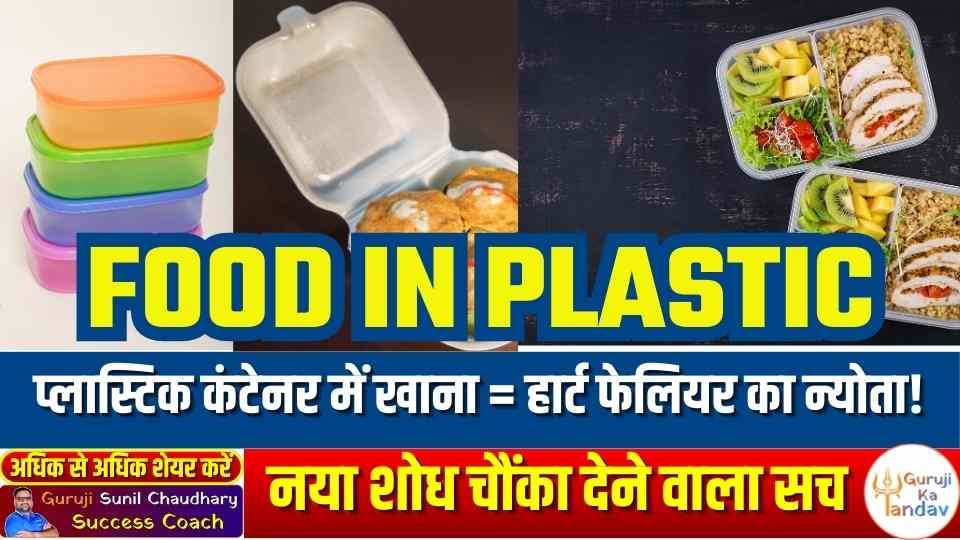In today’s fast-paced world, convenience often takes priority over health. Many people rely on food in plastic containers for takeout and storage. However, new research related to microplastic particles has revealed alarming risks associated with this habit. The latest studies indicate that eating from plastic containers increases heart failure risk and can cause long-term health complications.
This article explores the hidden dangers of plastic food containers, backed by scientific research, and provides practical solutions to minimize exposure to harmful plastic chemicals.
Why Plastic Containers Are Harmful for Food Storage
1. Plastic Releases Toxic Chemicals
Plastic food containers contain harmful chemicals such as:
- Bisphenol A (BPA) – Linked to hormone disruption and heart disease.
- Phthalates – Associated with metabolic disorders and reproductive issues.
- PFAS (Per- and Polyfluoroalkyl Substances) – Known as “forever chemicals,” they accumulate in the body over time.
When food is stored in plastic containers, especially hot food or acidic food, these chemicals leach into the food and enter the body upon consumption.
2. Microplastics Enter the Body
New research related to microplastic particles suggests that tiny plastic fragments enter our digestive system through contaminated food. Studies have shown that these particles:
- Damage gut health, leading to inflammation.
- Increase intestinal permeability, allowing harmful toxins to enter the bloodstream.
- Negatively impact the circulatory system, increasing the risk of heart disease.
According to a 2024 study published in Ecotoxicology and Environmental Safety, high exposure to plastics significantly increases the risk of congestive heart failure.
3. Heat Accelerates Chemical Leaching
Heating food in plastic containers, whether in a microwave, oven, or by adding hot liquids, significantly increases chemical leaching. A study conducted in China revealed that boiling water in plastic containers for just 15 minutes led to severe health effects in rats. This highlights how dangerous it can be for humans.
4. Plastic Contaminates the Environment
Aside from personal health risks, plastic containers contribute to environmental pollution. Improper disposal leads to plastic waste breaking down into microplastics, which contaminate:
- Water bodies, affecting marine life.
- Soil, impacting agricultural produce.
- Air, entering the respiratory system through airborne microplastics.
Scientific Evidence: How Plastic Containers Harm Your Heart
A recent study involving 3,000 Chinese participants and experiments on rats found that eating from plastic containers increases heart failure risk due to:
- Inflammation caused by microplastics
- Circulatory system damage due to toxin absorption
- Heart muscle weakening, observed in animal studies
These findings align with previous research linking BPA and phthalates to cardiovascular diseases. While specific chemicals responsible were not identified, the results emphasize the urgent need to reduce plastic exposure.
How to Reduce Plastic Exposure in Food Storage
✅ 1. Use Glass or Stainless Steel Containers
Instead of plastic, opt for:
✔ Glass containers – Safe, reusable, and non-toxic.
✔ Stainless steel lunchboxes – Durable and eco-friendly.
✔ Ceramic bowls – Ideal for heating food safely.
✅ 2. Avoid Heating Food in Plastic Containers
Never microwave or heat food in plastic containers. Instead:
✔ Transfer food to glass or ceramic bowls before reheating.
✔ Use silicone lids instead of plastic wrap in microwaves.
✅ 3. Choose Eco-Friendly Takeout Options
✔ Prefer restaurants that use biodegradable packaging.
✔ Carry your own reusable food containers when ordering takeout.
✔ Say no to single-use plastic containers whenever possible.
✅ 4. Store Dry Foods in Plastic-Free Containers
✔ Use mason jars or stainless steel canisters for grains, nuts, and spices.
✔ Avoid plastic packaging for grocery items whenever possible.
✅ 5. Be Aware of BPA-Free Labels
Many products claim to be BPA-free, but they often contain BPS (Bisphenol S), which is equally harmful. Always choose natural, non-plastic alternatives.
FAQs About Plastic Food Containers
❓ Is all plastic harmful for food storage?
Yes, even food-grade plastic can leach chemicals, especially when exposed to heat or acidic foods.
❓ Can I reuse plastic containers from takeout food?
No, single-use plastic containers degrade over time, increasing chemical leaching.
❓ Are biodegradable plastics safe?
Some biodegradable plastics contain hidden chemicals that may still be harmful. Natural materials like glass, ceramic, and stainless steel are safer choices.
❓ What are the symptoms of microplastic exposure?
Symptoms can include digestive issues, hormonal imbalances, fatigue, and cardiovascular problems over time.
Conclusion: Time to Ditch Plastic for Good!
It’s time to rethink our dependency on plastic. The new research related to microplastic particles confirms that eating from plastic containers increases heart failure risk and causes long-term health damage.
By making small changes, such as using safer food storage options, avoiding heating food in plastic, and choosing sustainable alternatives, we can protect our health and the environment.
🚀 Take Action Now!
✔ Switch to glass, stainless steel, or ceramic for food storage.
✔ Avoid microwaving food in plastic containers.
✔ Choose eco-friendly packaging whenever possible.
Your health is in your hands—make the right choices today!
💬 What are your thoughts on plastic food containers? Share your experience in the comments below! 🚀
#FoodInPlasticContainers #NewResearchRelatedToMicroplasticParticles #EatingFromPlasticContainersIncreasesHeartFailureRisk #NoToPlastic #SafeFoodStorage #Microplastics #HealthyLiving #PlasticPollution #HeartHealth #EcoFriendly


















